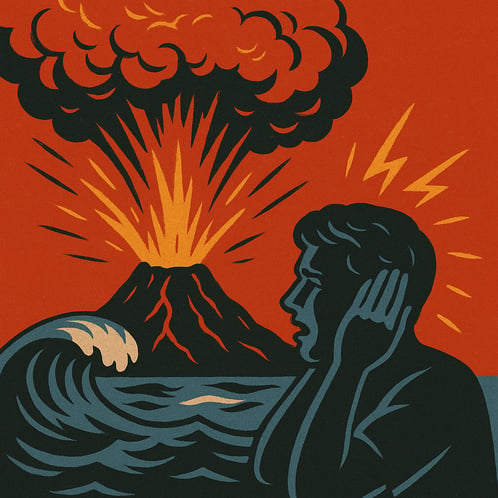The Loudest Sound Ever Heard
What’s the loudest sound ever heard on Earth? Discover the explosive story of Krakatoa, the volcanic eruption that shattered records—and eardrums.
NATURAL HORRORS
Driver
5/25/20253 min read


🌋 A Boom Heard Around the World
The loudest sound ever documented wasn’t man-made. It came from the volcanic island of Krakatoa, located in the Sunda Strait between Java and Sumatra (present-day Indonesia).
On the morning of August 27, 1883, after months of rumbling and erupting, Krakatoa unleashed its final, catastrophic explosion.
The result?
A sound so powerful that it was heard 3,000 miles away — the same as hearing a noise in New York from San Francisco.
Here’s what was reported:
People in Australia thought it was artillery fire.
In India, it shook windows and startled livestock.
In Mauritius, over 3,000 miles away, sailors thought their ship's boilers had exploded.
Even in places where no ash or lava fell, people heard the boom.
This wasn’t just a noise. It was a planetary event.
📊 Just How Loud Was It?
The Krakatoa explosion is estimated to have reached 310 decibels (dB).
Let’s put that in perspective:
Normal conversation: 60 dB
Rock concert: 120 dB
Jet engine at takeoff: 140 dB (pain threshold)
Eardrum rupture: 160 dB
Hiroshima atomic bomb: 170–180 dB
Krakatoa: 310 dB
Now, here’s the mind-blowing part:
At 194 dB, sound doesn’t just hurt — it becomes destructive. Air itself can't vibrate fast enough to carry it, and the sound wave turns into a shockwave.
So how could 310 dB happen?
Because this wasn’t sound in the normal sense. It was an acoustic mega-blast, powered by 200 megatons of TNT (roughly 13,000 times the power of the Hiroshima bomb).
📡 A Planet-Wide Shockwave
The pressure wave generated by Krakatoa didn’t stop at sound.
It created shockwaves in the atmosphere that circled the Earth not once… but seven times.
That’s right. Global barometers recorded massive pressure jumps as the shockwave bounced around the planet over the next 5 days.
You could "feel" Krakatoa from the other side of the globe — even if you didn’t hear it.
👂 The Damage Done to People
In nearby coastal towns, the explosion was so loud that it caused:
Eardrum ruptures
Temporary or permanent deafness
Disorientation and fainting
People who were 40 kilometers (25 miles) away had their clothes ripped off by the force of the blast.
One captain recorded in his logbook that his crew went temporarily deaf and couldn’t hear each other shouting, even while standing side by side.
🌊 Not Just Loud — Deadly
The noise wasn’t the only danger. The explosion triggered a tsunami over 40 meters (131 feet) high that killed more than 36,000 people — and possibly more, depending on whose records you trust.
Entire villages were swept away. Ash blanketed the region. Sunsets turned blood-red around the world for months due to the particles in the air.
Some scientists even suggest that the eruption cooled the Earth’s temperature for the next few years.
🔬 Why Was It So Loud?
Several factors combined to make Krakatoa’s blast unique:
Massive Pressure Build-Up:
Krakatoa’s magma chamber was sealed until it burst, like a super-volcano-sized pressure cooker.Ocean Interaction:
The explosion happened partially underwater, causing superheated steam and adding to the pressure wave.Geological Amplification:
The surrounding geography helped funnel the shockwave more efficiently than most eruptions.Scale of Detonation:
It wasn't just an eruption — it was a near-total destruction of the island itself. Over two-thirds of Krakatoa vanished in an instant.
🗣️ Can We Ever Hear Something That Loud Again?
Technically… no.
Humans can’t survive sound anywhere near that level. Anything above 200 dB at close range can kill you — through internal organ damage, brain trauma, or instant eardrum rupture.
Even if a modern bomb or space impact reached similar decibels, you'd be obliterated before you had the chance to say, “Did you hear that?”
Thankfully, nothing since 1883 has come close to Krakatoa’s audio apocalypse.
🧠 Fun Fact: The Krakatoa Effect
Some scientists call it the “Krakatoa Threshold” — the theoretical upper limit of sound on Earth before it stops being sound and becomes a physical shockwave.
After that point, there's no noise. Only force.
Which kind of makes Krakatoa... the loudest "non-sound" in history.
🌍 Legacy of the Boom
Krakatoa’s echo can still be felt today:
It inspired art, literature, and film.
It helped scientists understand atmospheric acoustics.
And it remains a benchmark in the study of natural disasters.
There’s even a new volcano rising where Krakatoa once stood, called Anak Krakatau — “Child of Krakatoa.”
Let’s hope it doesn’t try to outdo its parent.
🧩 Final Thought: When Silence Is Louder
Krakatoa was more than loud. It was existential. It was sound turned into fear, into power, into aftermath.
It reminds us how fragile our perception is, and how nature can express itself in ways that completely break the human scale.
So the next time you hear a loud thunderclap or a booming bass at a concert, remember:
You haven’t really heard LOUD — unless you heard Krakatoa.
📚 Sources / References:
Winchester, Simon. Krakatoa: The Day the World Exploded. Harper Perennial, 2005.
The Royal Society – Philosophical Transactions on Krakatoa eruption data (1888)
NOAA – National Centers for Environmental Information
Geological Society of London – Krakatoa Retrospective
NASA Earth Observatory – Volcanic Sound and Shockwave Analysis
